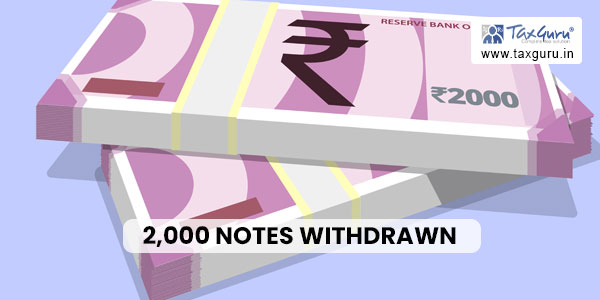Discover the reasons behind the Reserve Bank of India’s decision to withdraw Rs 2,000 denomination banknotes. Learn about the Clean Note Policy, legal tender status, depositing/exchanging process, limits, special provisions, and the impact on the economy. Stay informed and navigate the withdrawal seamlessly with this comprehensive guide.
The Reserve Bank of India (RBI) recently made an announcement regarding the withdrawal of Rs 2,000 denomination banknotes from circulation. This decision has sparked curiosity among the public, who are now seeking answers regarding the rationale behind this move and the process of depositing or exchanging these notes. In this comprehensive guide, we will delve into various aspects related to this decision, including the reasons behind it and the steps involved in depositing or exchanging Rs 2,000 notes.
Page Contents
- Reason for Withdrawing Rs 2,000 Denomination Banknotes
- Overview of the Clean Note Policy
- The Story of Rs 2,000 Notes
- Legal Tender Status of Rs 2,000 Notes
- Process of Depositing or Exchanging Rs 2,000 Notes
- Limits on Exchange and Deposit of Rs 2,000 Notes
- Special Provisions for Senior Citizens and Persons with Disabilities
- Grievance Redressal Mechanism
- Impact on the Economy
- Conclusion
Reason for Withdrawing Rs 2,000 Denomination Banknotes
The primary reason for withdrawing Rs 2,000 denomination banknotes is that their purpose has been fulfilled. These notes were initially introduced in November 2016 to meet the currency requirements of the economy after the withdrawal of all Rs 500 and Rs 1,000 banknotes as legal tender. Since then, an adequate quantity of banknotes in other denominations has been made available, and the printing of Rs 2,000 banknotes ceased in 2018-19. Most of the Rs 2,000 notes currently in circulation were issued before March 2017 and have reached the end of their estimated lifespan of 4-5 years. Moreover, this denomination is not commonly used for transactions, and there are enough banknotes of other denominations to meet the public’s currency needs. With the objective of ensuring the availability of good quality banknotes, as part of the “Clean Note Policy,” the RBI has decided to withdraw the Rs 2,000 denomination banknotes.
Overview of the Clean Note Policy
The Clean Note Policy was introduced by the RBI 24 years ago, in 1999, under the leadership of then RBI Governor, Dr. Bimal Jalan. The main goal of this policy is to provide citizens with high-quality currency notes and coins while maintaining the integrity of the Indian currency by removing damaged, counterfeit, or soiled notes from circulation. The RBI continuously monitors the quality of currency notes in circulation and sets standards for their acceptability. Over the years, the RBI has implemented various measures to promote the use of clean notes, such as discontinuing the practice of stapling note packets and adopting banding with paper/polythene bands to increase the lifespan of currency notes.

The Story of Rs 2,000 Notes
Printing of Rs 2,000 banknotes commenced in 2016 following the demonetization of Rs 1,000 and Rs 500 notes announced by Prime Minister Narendra Modi. As the availability of banknotes in other denominations improved, the printing of Rs 2,000 notes was stopped in 2018-19. A significant majority (89%) of the Rs 2,000 denomination banknotes were issued before March 2017 and are nearing the end of their estimated lifespan of four to five years. The total value of these banknotes in circulation has decreased from its peak of Rs 6.73 lakh crore on March 31, 2018 (37.3% of notes in circulation) to Rs 3.62 lakh crore, constituting only 10.8% of notes in circulation as of March 31. As a result, the RBI has instructed all banks to cease issuing Rs 2,000 notes. Individuals now have the opportunity to deposit or exchange lower denomination notes up to Rs 20,000 at a time from May 23 to September 30.
Legal Tender Status of Rs 2,000 Notes
Rs 2,000 banknotes will continue to retain their legal tender status, allowing the public to use them for transactions and accept them as payment. However, the RBI encourages individuals to deposit and/or exchange these banknotes on or before September 30, 2023.
Process of Depositing or Exchanging Rs 2,000 Notes
To deposit or exchange Rs 2,000 banknotes, individuals can visit bank branches. The facility for depositing into accounts and exchanging for Rs 2,000 banknotes will be available at all banks starting May 23, 2023, until September 30, 2023. The option to exchange will also be provided at the 19 Regional Offices (ROs) of the RBI that have Issue Departments until September 30, 2023.
Limits on Exchange and Deposit of Rs 2,000 Notes
There are no restrictions on depositing Rs 2,000 notes into bank accounts, provided individuals comply with the existing Know Your Customer (KYC) norms and other applicable statutory/regulatory requirements. However, when it comes to exchanging Rs 2,000 notes, there is a limit of Rs 20,000 at a time, allowing for the exchange of up to 10 banknotes. Even individuals without bank accounts can exchange Rs 2,000 banknotes up to a limit of Rs 20,000 at a time at any bank branch. There are no limitations on the amount that can be deposited. Rs 2,000 banknotes can be deposited into bank accounts, and funds can be withdrawn against these deposits.
Special Provisions for Senior Citizens and Persons with Disabilities
Banks have been directed to make arrangements to minimize inconvenience for senior citizens, persons with disabilities, and others seeking to exchange/deposit Rs 2,000 banknotes. These arrangements may include dedicated counters or assistance in completing the necessary formalities.
Grievance Redressal Mechanism
If a bank refuses to exchange or accept Rs 2,000 notes, individuals should file an official complaint with the concerned bank. If the bank fails to respond within 30 days or if the complainant is dissatisfied with the bank’s response, they can lodge a complaint under the Reserve Bank – Integrated Ombudsman Scheme (RB-IOS), 2021, at the Complaint Management System portal of RBI (cms.rbi.org.in).
Impact on the Economy
The withdrawal of Rs 2,000 denomination banknotes may have a temporary impact on the economy, potentially leading to a short-term cash crunch, particularly in rural areas with limited access to ATMs and banking facilities. However, the RBI’s assurance of sufficient availability of banknotes in other denominations should help alleviate this concern. In the long run, the withdrawal of Rs 2,000 notes could aid in curbing the generation of black money, reducing cash transactions, and promoting digital transactions and financial inclusion.
Conclusion
The withdrawal of Rs 2,000 denomination banknotes is a significant step taken by the RBI to ensure the availability of good quality banknotes, promote digital transactions, and curb the generation of black money. By adhering to the guidelines provided by the RBI and staying updated on the latest updates and instructions issued by the RBI and the government, individuals can deposit or exchange their Rs 2,000 notes seamlessly within the specified timeframe. It is crucial to stay informed and plan accordingly to facilitate a hassle-free experience.





